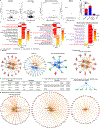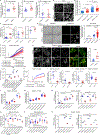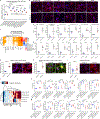Cholesterol and matrisome pathways dysregulated in astrocytes and microglia
- PMID: 35750033
- PMCID: PMC9340815
- DOI: 10.1016/j.cell.2022.05.017
Cholesterol and matrisome pathways dysregulated in astrocytes and microglia
Abstract
The impact of apolipoprotein E ε4 (APOE4), the strongest genetic risk factor for Alzheimer's disease (AD), on human brain cellular function remains unclear. Here, we investigated the effects of APOE4 on brain cell types derived from population and isogenic human induced pluripotent stem cells, post-mortem brain, and APOE targeted replacement mice. Population and isogenic models demonstrate that APOE4 local haplotype, rather than a single risk allele, contributes to risk. Global transcriptomic analyses reveal human-specific, APOE4-driven lipid metabolic dysregulation in astrocytes and microglia. APOE4 enhances de novo cholesterol synthesis despite elevated intracellular cholesterol due to lysosomal cholesterol sequestration in astrocytes. Further, matrisome dysregulation is associated with upregulated chemotaxis, glial activation, and lipid biosynthesis in astrocytes co-cultured with neurons, which recapitulates altered astrocyte matrisome signaling in human brain. Thus, APOE4 initiates glia-specific cell and non-cell autonomous dysregulation that may contribute to increased AD risk.
Keywords: APOE; Alzheimer; astrocytes; cholesterol; genetic heterogeneity; haplotypes; iPSC disease modeling; inflammation; matrisome; microglia.
Copyright © 2022 Elsevier Inc. All rights reserved.
Conflict of interest statement
Declaration of interests J.TCW. co-founded Asmos Therapeutics, LLC, serves on the scientific advisory board of NeuCyte, Inc, and has consulted for FIND Genomics Inc., CareCureSystems Corporation, TheWell Biosciences Inc., and Aleta Neuroscience, LLC. A.M.G. has consulted for Eisai, Biogen, Pfizer, AbbVie, Cognition Therapeutics, and GSK and served on the scientific advisory board at Denali Therapeutics from 2015–2018. D.M.H. co-founded and is on the scientific advisory board of C2 N Diagnostics, LLC (licensed anti-tau antibody to AbbVie) and the scientific advisory board of Denali and consults for Genentech and Idorsia. F.R.M. has consulted for Denali Therapeutics in 2019. W.W.P. is a co-inventor of patent WO/2018/160496 (microglia differentiation).
Figures







Comment in
-
APOE told me put my fat in the bag and nobody gets hurt.Cell. 2022 Jun 23;185(13):2201-2203. doi: 10.1016/j.cell.2022.05.028. Cell. 2022. PMID: 35750028
References
-
- Andreone BJ, Przybyla L, Llapashtica C, Rana A, Davis SS, van Lengerich B, Lin K, Shi J, Mei Y, Astarita G, et al. (2020). Alzheimer’s-associated PLCgamma2 is a signaling node required for both TREM2 function and the inflammatory response in human microglia. Nature neuroscience - PubMed
-
- Barcia C, Ros CM, Annese V, Gomez A, Ros-Bernal F, Aguado-Yera D, Martinez-Pagan ME, de Pablos V, Fernandez-Villalba E, and Herrero MT (2011). IFN-gamma signaling, with the synergistic contribution of TNF-alpha, mediates cell specific microglial and astroglial activation in experimental models of Parkinson’s disease. Cell Death Dis 2, e142. - PMC - PubMed
Publication types
MeSH terms
Substances
Grants and funding
- P30 AG066444/AG/NIA NIH HHS/United States
- R01 HL093324/HL/NHLBI NIH HHS/United States
- RF1 NS090934/NS/NINDS NIH HHS/United States
- RF1 AG057440/AG/NIA NIH HHS/United States
- S10 OD021718/OD/NIH HHS/United States
- RF1 AG054014/AG/NIA NIH HHS/United States
- U01 AG046170/AG/NIA NIH HHS/United States
- P30 AG066519/AG/NIA NIH HHS/United States
- K01 AG062683/AG/NIA NIH HHS/United States
- RF1 AG074010/AG/NIA NIH HHS/United States
- RF1 AG047644/AG/NIA NIH HHS/United States
- U19 AG069701/AG/NIA NIH HHS/United States
- S10 OD010794/OD/NIH HHS/United States
- RF1 AG068992/AG/NIA NIH HHS/United States
- U01 AG058635/AG/NIA NIH HHS/United States
- S10 RR025496/RR/NCRR NIH HHS/United States
- P50 AG016573/AG/NIA NIH HHS/United States
LinkOut - more resources
Full Text Sources
Medical
Molecular Biology Databases
Miscellaneous

